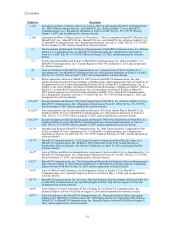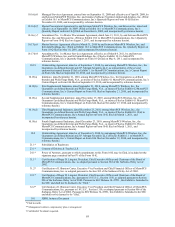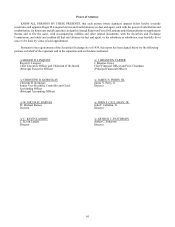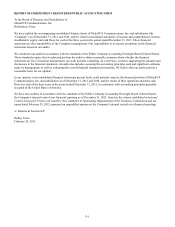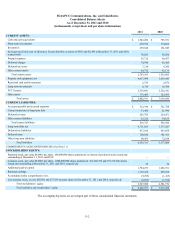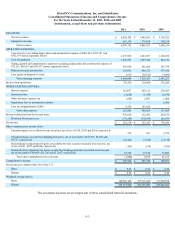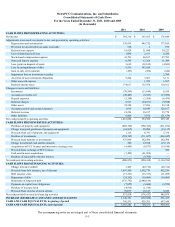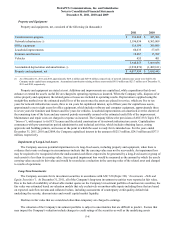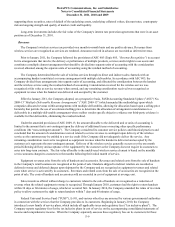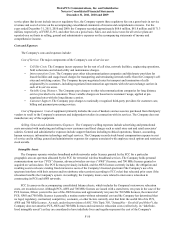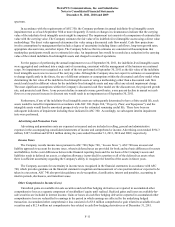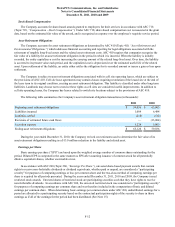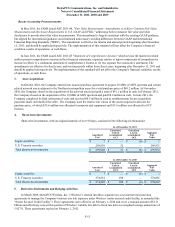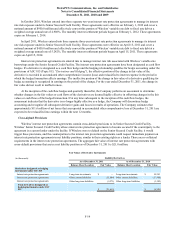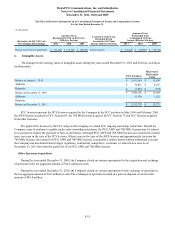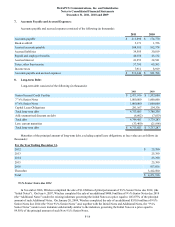Metro PCS 2011 Annual Report Download - page 112
Download and view the complete annual report
Please find page 112 of the 2011 Metro PCS annual report below. You can navigate through the pages in the report by either clicking on the pages listed below, or by using the keyword search tool below to find specific information within the annual report.MetroPCS Communications, Inc. and Subsidiaries
Notes to Consolidated Financial Statements
December 31, 2011, 2010 and 2009
F-6
1. Organization and Business Operations:
MetroPCS Communications, Inc. (“MetroPCS”), a Delaware corporation, together with its consolidated subsidiaries (the
“Company”), is a wireless telecommunications carrier that offers wireless broadband mobile services in selected major
metropolitan areas in the United States. As of December 31, 2011, the Company offered services primarily in the metropolitan
areas of Atlanta, Boston, Dallas/Fort Worth, Detroit, Las Vegas, Los Angeles, Miami, New York, Orlando/Jacksonville,
Philadelphia, Sacramento, San Francisco and Tampa/Sarasota. The Company sells products and services to customers through
Company-owned retail stores as well as through relationships with independent retailers.
On November 24, 2004, MetroPCS, through its wholly-owned subsidiaries, and C9 Wireless, LLC, an independent third-
party, formed Royal Street Communications, LLC (“Royal Street Communications”), to bid on spectrum auctioned by the
Federal Communications Commission (“FCC”) in Auction 58. The Company owned 85% of the limited liability company
member interest of Royal Street Communications through December 22, 2010, when MetroPCS completed the acquisition of
the remaining 15% limited liability company member interest in Royal Street Communications for total consideration of $9.8
million, resulting in Royal Street Communications and its wholly-owned subsidiaries becoming wholly-owned subsidiaries of
the Company. Prior to the acquisition of the remaining membership interest, the Company consolidated its interest in Royal
Street in accordance with Financial Accounting Standards Board (“FASB”) Accounting Standards Codification (“ASC”) 810
(Topic 810, “Consolidation”). Royal Street qualified as a variable interest entity under ASC 810 because the Company was the
primary beneficiary of Royal Street and absorbed all of Royal Street's losses. All intercompany accounts and transactions
between the Company and Royal Street have been eliminated in the consolidated financial statements.
2. Summary of Significant Accounting Policies:
Consolidation
The accompanying consolidated financial statements include the balances and results of operations of MetroPCS and its
wholly-owned subsidiaries. All intercompany balances and transactions have been eliminated in consolidation.
Operating Segments
ASC 280 (Topic 280, “Segment Reporting”), establishes standards for the way that public business enterprises report
information about operating segments in annual financial statements. At December 31, 2011, the Company had thirteen
operating segments based on geographic regions within the United States: Atlanta, Boston, Dallas/Fort Worth, Detroit, Las
Vegas, Los Angeles, Miami, New York, Orlando/Jacksonville, Philadelphia, Sacramento, San Francisco and Tampa/Sarasota.
The Company aggregates its operating segments into one reportable segment.
Use of Estimates in Financial Statements
The preparation of financial statements in conformity with accounting principles generally accepted in the United States
of America (“GAAP”) requires management to make estimates and assumptions that affect the reported amounts of certain
assets and liabilities and disclosure of contingent assets and liabilities at the date of the financial statements and the reported
amounts of revenues and expenses during the reporting period. Actual results could differ from those estimates. The most
significant of such estimates used by the Company include:
• valuation of inventories;
• estimated useful life of property and equipment;
• impairment of long-lived assets and indefinite-lived assets;
• likelihood of realizing benefits associated with temporary differences giving rise to deferred tax assets;
• reserves for uncertain tax positions;
• asset retirement obligations;
• determining fair value of FCC licenses; and
• stock-based compensation expense.


